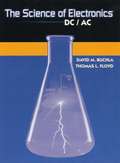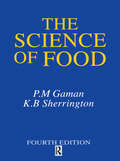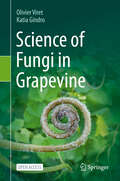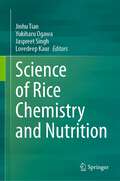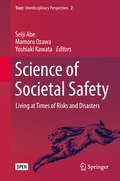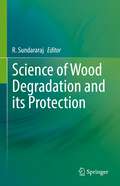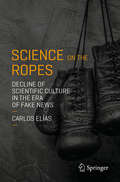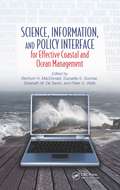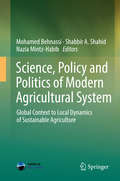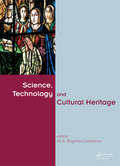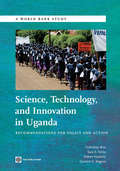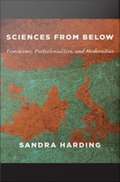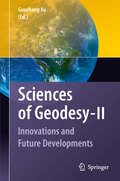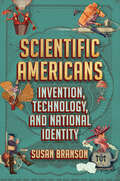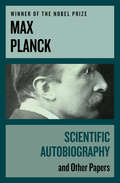- Table View
- List View
Science of Electronics: DC/AC
by David M. Buchla Thomas L. FloydThe book presents clear and comprehensive coverage of fundamental elements of DC/AC circuits with a strong emphasis on the science and necessary math.
Science of Food: An Introduction To Food Science, Nutrition And Microbiology
by K. B. Sherrington P. M. GamanFirst Published in 1998. Routledge is an imprint of Taylor & Francis, an informa company.
Science of Fungi in Grapevine
by Olivier Viret Katia GindroThis open access book provides a comprehensive exploration of the relationship between fungi and grapevines, covering contemporary mycological classifications, pathogens, the mycobiome, endophytes, and mycorrhizae. Inspired by the French book "La Vigne, Maladies Fongiques" by the same authors, which won first prize at the 2015 OIV book competition (Organisation Internationale de la Vigne et du Vin, Dijon), this work aims to extend and update that foundational text. The introduction delves into the origins and adaptability of grapevines in response to evolving fungal diseases, alongside an overview of their biology, epidemiology, and control measures. The second chapter covers the systematics of the genus Vitis, the developmental stages of the vine, the anatomy of various organs, the history and breeding of resistant varieties, and the natural defense mechanisms of grapevines against fungal infections. A significant portion of the book provides the latest insights into mycology, including chapters on fungal systematics and taxonomy, as well as the concepts of holobiome, microbiome, and mycobiome in relation to grapevines. The third part focuses on fungal diseases affecting green organs, wood, and roots, illustrated at macroscopic, microscopic, and ultrastructural levels, and includes discussions on disease cycles and epidemiology. Additionally, there is a chapter dedicated to grafting systems and the specificity of fungi in nurseries. The final chapter addresses the control of fungal diseases, from historical perspectives to modern chemical groups of active ingredients, natural fungicides, and comprehensive disease management strategies. This includes application techniques, calibration of spraying equipment, drift reduction, and proper storage and handling of fungicides. This open access book serves as a key reference on the complex interactions between fungi and grapevines for scientists, students, and winegrowers, offering extensive practical knowledge and a rich scientific background based on over thirteen years of research by the authors.
Science of Rice Chemistry and Nutrition
by Jaspreet Singh Jinhu Tian Yukiharu Ogawa Lovedeep KaurThis book presents the knowledge of rice chemistry and nutrition. It includes identification, analysis, and application of bioactive chemical components of rice, the starch digestibility after pre-treatment, domestic cooking or processing, and the structure changes at multiple scales during processing and digestion. The novel application of rice starch, protein, polyphenols, dietary fiber, and the next generation of healthy rice products is summarized and the underline mechanisms of starch digestion are also revealed. Particularly, the advanced technologies for the fortification of rice nutrition as well as the challenges for the future rice processing industry are also included. This book provides the most recent research progresses and the state-of-the-art technologies regarding rice nutrition & chemistry to students, researchers, and technologists who are interested in rice and the fields of food science, nutrition, and food engineering.
Science of Societal Safety: Living At Times Of Risks And Disasters (Trust Ser. #2)
by Seiji Abe Mamoru Ozawa Yoshiaki KawataThis open access book covers comprehensive but fundamental principles and concepts of disaster and accident prevention and mitigation, countermeasures, and recovery from disasters or accidents including treatment and care of the victims. Safety and security problems in our society involve not only engineering but also social, legal, economic, cultural, and psychological issues. The enhancement needed for societal safety includes comprehensive activities of all aspects from precaution to recovery, not only of people but also of governments. In this context, the authors, members of the Faculty of Societal Safety Science, Kansai University, conducted many discussions and concluded that the major strategy is consistent independently of the type and magnitude of disaster or accident, being also the principle of the foundation of our faculty.The topics treated in this book are rather widely distributed but are well organized sequentially to provide a clear understanding of the principles of societal safety. In the first part the fundamental concepts of safety are discussed. The second part deals with risks in the societal and natural environment. Then follows, in the third part, a description of the quantitative estimation of risk and its assessment and management. The fourth part is devoted to disaster prevention, mitigation, and recovery systems. The final, fifth part presents a future perspective of societal safety science.Thorough reading of this introductory volume of societal safety science provides a clear image of the issues. This is largely because the Japanese have suffered often from natural disasters and not only have gained much valuable information about disasters but also have accumulated a store of experience. We are still in the process of reconstruction from the Great East Japan earthquake and the Fukushima nuclear power plant accident. This book is especially valuable therefore in studying the safety and security of people and their societies.
Science of Wood Degradation and its Protection
by R. SundararajThis edited book covers all aspects of wood degradation from its formation and growing in trees to its end usages when it is put into human usage. Wood is an age-old traditional fascinating material with a sensory-rich immersive experience that kindles aesthetics and creativity. The utility, durability, and functionality of wood render it a cosmopolitan material. It constitutes an integral part of human lives from ancient times to modern societies being used by various sectors viz., construction, furniture, panel products, paper and pulp, sports goods, agricultural implements, etc., Wood, being a biological material, is susceptible to degradation both by physical and biological means, and the need to protect the wood and prevent heavy economic losses constitutes a major challenge. Also, wood formed by the trees is the major sinks of carbon and the carbon remains locked-up for the life of the wood, thereby serving as important tool to mitigate the climate change. But the carbon stored in wood returns to the atmosphere when it degrades and will have positive effect on climate change. Hence, wood protection aiming for extending the service life of wood plays a key role in locking the carbon for a longer period in the wood and also substantially reduce the demand and depletion of forest resources. The book focuses on wood as an important natural bio-resource, inventory of wood protection, usage, utilization, preservatives, protection technologies and wood protection from all forms of degradation. Special focus is given on the eco-friendly way of protecting wood and its importance in mitigating climate change. The book is useful for Indian and international readers, who are working in wood domains. It is of interest to wood technologists, teachers, researchers, climate change scientists, capacity builders, and policymakers. It is of immense importance as a guide and study material to the graduate and postgraduate students of wood science in various universities of India and abroad.
Science on the Ropes: Decline of Scientific Culture in the Era of Fake News
by Carlos ElíasIn this controversial essay, Carlos Elías addresses the worldwide phenomenon that is threatening the scientific and economic progress of Western countries. The rise and influence of magic and irrationality in the media, in social networks and at universities is a disturbing phenomenon: many Western students no longer want to pursue STEM (Science, Technologies, Engineering, and Math) careers. This lucid and well-written book addresses one of the key issues of public debate: the deteriorating state of science in Western countries and their governments, and its rise in Asian countries. The author compares two distinct models: the Spanish or Latin model, which closed the door on science with the Counter-Reformation, and that employed by a second group of countries where science was encouraged. Elías suggests that a similar development could now be taking place between Western countries (where the press, television and social science academics are becoming increasingly critical towards science) and Asia, where most prime ministers (and other politicians) are scientists or engineers. This book is intended for STEM educators (both at secondary schools and universities), scientists and academics interested in scientific culture in the era of fake news.
Science, Information, and Policy Interface for Effective Coastal and Ocean Management
by Bertrum H. MacDonaldThis book provides a timely analysis of the role that information-particularly scientific information-plays in the policy-making and decision-making processes in coastal and ocean management. It includes contributions from global experts in marine environmental science, marine policy, fisheries, public policy and administration, resource management
Science, Policy and Politics of Modern Agricultural System
by Shabbir A. Shahid Mohamed Behnassi Nazia Mintz-HabibThis book arises from a 2011 international conference entitled Climate Change, Agri-Food, Fisheries and Ecosystems: Reinventing Research, Innovation, and Policy Agendas for an Environmentally and Socially-Balanced Growth (ICCAFFE2011), organized by the North-South Center for Social Sciences (NRCS) in collaboration with the Deutsche Gesellschaft für Internationale Zusammenarbeit (GIZ) GmbH, Germany and the Institute for Research and Development (IRD), France. Coverage focuses on the agricultural sector and helps improve understanding of the relationships between agriculture and the environment and between human communities and nature, so as to sustainably manage agricultural development. The contributors analyze the interdependence between sustainable agricultural development and environmental, economic and social dynamics; assess the impacts of soil degradation on agricultural productivity; present ways to enhance livestock production and recommend mechanisms for managing links between agro-biodiversity, climate change and livelihoods. Part I examines sustainable agriculture development and environmental, economic and social dynamics, addressing topics such as global climate change, agriculture and challenges including socio-economic factors, adaptation, poverty reduction and water management. Part II covers the impacts of soil degradation on agricultural productivity and discusses the use of expert systems to assess and manage degraded lands, agricultural productivity, land suitability and rehabilitation. Part III focuses on livestock production enhancements, such as feed resources and supplemental feeds for animals and capacity building for women in dairy management. Part IV shares the outcomes of research in agro-biodiversity, climate change and livelihoods, addressing topics such as co-management of forests, carbon consumption models, biodiversity conservation and carbon sequestration and scarce mangrove forests. Current environmental and agro-ecological research focuses on understanding the cause-consequence relationships between specific agricultural practices and land use and the responses at different levels of ecosystems. This book is intended to contribute to this discussion.
Science, Policy, And The Value-free Ideal
by Heather DouglasThe role of science in policymaking has gained unprecedented stature in the United States, raising questions about the place of science and scientific expertise in the democratic process. Some scientists have been given considerable epistemic authority in shaping policy on issues of great moral and cultural significance, and the politicizing of these issues has become highly contentious. Since World War II, most philosophers of science have purported the concept that science should be “value-free.” In Science, Policy and the Value-Free Ideal, Heather E. Douglas argues that such an ideal is neither adequate nor desirable for science. She contends that the moral responsibilities of scientists require the consideration of values even at the heart of science. She lobbies for a new ideal in which values serve an essential function throughout scientific inquiry, but where the role values play is constrained at key points, thus protecting the integrity and objectivity of science. In this vein, Douglas outlines a system for the application of values to guide scientists through points of uncertainty fraught with moral valence. Following a philosophical analysis of the historical background of science advising and the value-free ideal, Douglas defines how values should-and should not-function in science. She discusses the distinctive direct and indirect roles for values in reasoning, and outlines seven senses of objectivity, showing how each can be employed to determine the reliability of scientific claims. Douglas then uses these philosophical insights to clarify the distinction between junk science and sound science to be used in policymaking. In conclusion, she calls for greater openness on the values utilized in policymaking, and more public participation in the policymaking process, by suggesting various models for effective use of both the public and experts in key risk assessments.
Science, Technology and Cultural Heritage
by Miguel Ángel Rogerio-CandeleraThe Second International Congress on Science and Technology for the Conservation of Cultural Heritage was held in Seville, Spain, June 24-27, 2014, under the umbrella of the TechnoHeritage network. TechnoHeritage is an initiative funded by the Spanish Ministry of Economy and Competitivity dedicated to the creation of a network which integrates CSIC
Science, Technology and Innovation in Uganda
by Sukhdeep Brar Robert Hawkins Sara E. Farley Caroline S WagnerScience, Technology and Innovation in Uganda is part of the World Bank Studies series. These papers are published to communicate the results of the Bank's ongoing research and to stimulate public discussion. This study presents a unique methodology to view science, technology and innovation (STI) in developing countries. The study provides a set of cases studies drawn from a diverse range of experiences across the Ugandan private sector and offers concrete policy recommendations on how to support broader development of STI in Uganda. The study finds that of all the STI challenges facing firms, universities, and public research organizations in Uganda, the barriers to collaboration and communication are the most urgent in terms of STI priorities to address in the coming years.
Science, Technology and Society
by Martin Bridgstock Ian Lowe David Burch John Forge John LaurentThis book provides a comprehensive introduction to the human, social and economic aspects of science and technology. It examines a broad range of issues from a variety of perspectives, using examples and experiences from around the world. The authors present complex issues, including the responsibilities of scientists, ethical dilemmas and controversies, the Industrial Revolution, economic issues, public policy, and science and technology in developing countries. The book ends with a thoughtful and provocative look toward the future. It features extensive guides to further reading, as well as a useful section on information searching skills. This book will provoke, engage, inform and stimulate thoughtful discussion about culture, society and science. Broad and interdisciplinary, it will be of considerable value to both students and teachers.
Science-Based Pest Management for a Sustainable and Resilient Coconut Sector
by Jelfina Constansje Alouw Aluthwala Hewa Nuwan ChinthakaThis book offers a practical and innovative guide to managing the complex relationship between coconut plantations and insect pests. It focuses on effective solutions for pest identification, monitoring, and management through a blend of cutting-edge technologies and traditional approaches. The coconut palm, aptly called the "tree of life," sustains millions of people across tropical regions, providing food, income, and livelihoods. Cultivated on approximately 12 million hectares globally, coconut production faces unprecedented challenges. Meeting the growing demand for diverse coconut products—from coconut water and oil to emerging uses like sustainable aviation fuel (SAF)—requires balancing food security with renewable energy needs. Adding to these challenges are pest infestations, including insects, mites, and vertebrates, which can cause crop losses of up to 30%. These threats not only lower yields but also jeopardise income and food security for coconut-dependent communities. Across the chapters, prominent coconut sector researchers and academics delve into pest biology, ecology, plant-pest interactions, climate change effects, organic farming, molecular tools, regulatory frameworks, and best practices for pest management. It contains detailed strategies for breeding coconut palms with enhanced pest resistance and addresses critical topics such as biosecurity and the global exchange of coconut germplasm. With its unique emphasis on practices and real-world applications, this volume is an essential resource for researchers, agricultural professionals, practitioners, and policymakers committed to building a resilient coconut sector.
Science: Teaching School Subjects 11-19 (Teaching School Subjects 11-19)
by Keith S. Taber Vanessa KindIn recognizing that new teachers often feel disempowered by the subject expertise they bring into teaching, this book not only covers the training standards for NQTs and the Induction Standards, but takes the reader beyond this by fully exploring issues relating to subject knowledge in learning to teach.Divided into three sections the book covers: framing the subject - defining subject knowledge and focusing on questions about science as a school subject teaching the subject - looking at pedagogical, curricular and pupil knowledge science within the professional community - focusing on the place of science within the wider curriculum and the teaching community. This refreshing new book provides stimulating assistance to subject specialists, from new teachers of science in the early years of professional development to those on a PGCE course or in their induction year. It is also suitable for subject leaders with mentor responsibilities and Advanced Skills Teachers undertaking specialist inset and teaching support.
Science: Teaching School Subjects 11-19 (Teaching School Subjects 11-19)
by Keith Taber Vanessa KindIn recognizing that new teachers often feel disempowered by the subject expertise they bring into teaching, this book not only covers the training standards for NQTs and the Induction Standards, but takes the reader beyond this by fully exploring issues relating to subject knowledge in learning to teach. Divided into three sections the book covers: framing the subject - defining subject knowledge and focusing on questions about science as a school subject teaching the subject - looking at pedagogical, curricular and pupil knowledge science within the professional community - focusing on the place of science within the wider curriculum and the teaching community. This refreshing new book provides stimulating assistance to subject specialists, from new teachers of science in the early years of professional development to those on a PGCE course or in their induction year. It is also suitable for subject leaders with mentor responsibilities and Advanced Skills Teachers undertaking specialist inset and teaching support.
ScienceSaurus: A Student Handbook
by Great Source Education GroupScienceSaurus is a resource book and a student handbook that offers step-by-step guidelines and clear examples of key science topics that include Life Science, Earth Science and Physical Science.
Sciences from Below: Feminisms, Postcolonialities, and Modernities
by Sandra HardingIn Sciences from Below, the esteemed feminist science studies scholar Sandra Harding synthesizes modernity studies with progressive tendencies in science and technology studies to suggest how scientific and technological pursuits might be more productively linked to social justice projects around the world. Harding illuminates the idea of multiple modernities as well as the major contributions of post-Kuhnian Western, feminist, and postcolonial science studies. She explains how these schools of thought can help those seeking to implement progressive social projects refine their thinking to overcome limiting ideas about what modernity and modernization are, the objectivity of scientific knowledge, patriarchy, and Eurocentricity. She also reveals how ideas about gender and colonialism frame the conventional contrast between modernity and tradition. As she has done before, Harding points the way forward in Sciences from Below. Describing the work of the post-Kuhnian science studies scholars Bruno Latour, Ulrich Beck, and the team of Michael Gibbons, Helga Nowtony, and Peter Scott, Harding reveals how, from different perspectives, they provide useful resources for rethinking the modernity versus tradition binary and its effects on the production of scientific knowledge. Yet, for the most part, they do not take feminist or postcolonial critiques into account. As Harding demonstrates, feminist science studies and postcolonial science studies have vital contributions to make; they bring to light not only the male supremacist investments in the Western conception of modernity and the historical and epistemological bases of Western science but also the empirical knowledge traditions of the global South. Sciences from Below is a clear and compelling argument that modernity studies and post-Kuhnian, feminist, and postcolonial sciences studies each have something important, and necessary, to offer to those formulating socially progressive scientific research and policy.
Sciences of Geodesy - I
by Guochang XuThis reference and handbook includes contributions from the world's leading experts and describes the history, theory, development, research highlights, problems and future of the individual geodetic fields. The subjects include: Geodesy, Satellite Geodesy, Marine Geodesy, GPS / Galileo Systems, Navigation and Positioning, Aerogravimetry, Super-conducting Gravimetry, Adjustment and Filtering, Orbits Theory, Orbits Determination, Tectonics, Earth Rotation and Polar Motion, Earth Tide and Ocean Loading Tide, Satellite Altimetry, Remote Sensing, InSAR, etc.
Sciencesaurus: A Student Handbook
by Great Source Education GroupThis book addresses key science topics including: scientific investigation; working in the lab; life science; earth science; physical science; natural resources and the environment; science, technology, and society. An ideal resource in science class, during lab time, and at home, this book also includes a handy almanac with tables, charts and graphs, test-taking and researching skills, science timelines and glossaries, and more.
Scientific Americans: Invention, Technology, and National Identity
by Susan BransonIn Scientific Americans, Susan Branson explores the place of science and technology in American efforts to achieve cultural independence from Europe and America's nation building in the early republic and antebellum eras. This engaging tour of scientific education and practices among ordinary citizens charts the development of nationalism and national identity alongside roads, rails, and machines.Scientific Americans shows how informal scientific education provided by almanacs, public lectures, and demonstrations, along with the financial encouragement of early scientific societies, generated an enthusiasm for the application of science and technology to civic, commercial, and domestic improvements. Not only that: Americans were excited, awed, and intrigued with the practicality of inventions. Bringing together scientific research and popular wonder, Branson charts how everything from mechanical clocks to steam engines informed the creation and expansion of the American nation. From the Exhibition of the Industry of All Nations to the fate of the Amistad captives, Scientific Americans shows how the promotion and celebration of discoveries, inventions, and technologies articulated Americans' earliest ambitions, as well as prejudices, throughout the first American century.
Scientific Autobiography: And Other Papers
by Max PlanckIn this fascinating autobiography from one of the foremost geniuses of twentieth-century physics, Max Planck tells the story of his life, his aims, and his thinking. Published posthumously, the papers in this volume were written for the general reader and make accessible Planck&’s scientific theories as well as his philosophical ideals, including his thoughts on ethics and morals.
Scientific Autobiography: And Other Papers
by Max PlanckIn this fascinating autobiography from one of the foremost geniuses of twentieth-century physics, Max Planck tells the story of his life, his aims, and his thinking. Published posthumously, the papers in this volume were written for the general reader and make accessible Planck&’s scientific theories as well as his philosophical ideals, including his thoughts on ethics and morals.
Scientific Ballooning: Technology and Applications of Exploration Balloons Floating in the Stratosphere and the Atmospheres of Other Planets
by Naoki Izutsu Toyoo Abe Nobuyuki Yajima Takeshi ImamuraThe aim of this book is to introduce scientific ballooning to the many people who are interested in the use of balloons for scientific applications. The book offers a basic understanding of the engineering details and the scientific research giving rise to balloon activities going on today. Above all, the book will serve as a guidebook for young scientists and researchers seeking to become involved in space science and technology by participating in balloon projects. The book deals with three types of balloons: large stratospheric balloons used for scientific purposes, rubber balloons used for aerological observations, and planetary balloons to be used in the atmospheres of other planets. The book provides many figures and photographs, and offers a systematic description of balloon technologies and related matters from historical background to current research topics. The contents include a theoretical discussion of ballon shape design, analysis and synthesis of flight dynamics, actual launching procedure, flight operations, and typical applications of ballooning in various scientific fields. Detailed meteorological descriptions, especially of the Earth's stratosphere and the atmosphere of other planets, are provided for investigating actual flight behavior.
